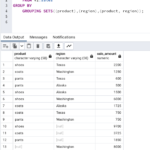T-SQL is a very powerful language when dealing with sets and in this post, I am going to be demonstrating how to use derived tables.
Derived tables are not the same as a temporary or physical tables where the fields and data types are declared. Nor are they subqueries. Instead, as the name implies, the table is derived from an existing table. I liken them to views but a view is an object that is created and is re-usable. A derived table is only available at execution time and not a re-usable object within the query. In other words, you cannot reference it multiple times like you can with common table expressions (CTE’s).
Basic syntax of the derived table
SELECT Field1, Field2 FROM (SELECT * FROM Table) Table1
So lets put the syntax to something more real:
USE AdventureWorks2012 GO SELECT TOP 10 FirstName, LastName FROM (SELECT * FROM Person.Person) AS PersonDerivedTable WHERE LastName = 'Smith';
FirstName LastName --------------- --------------- Abigail Smith Adriana Smith Alexander Smith Alexandra Smith Alexis Smith Allen Smith Alyssa Smith Andre Smith Andrew Smith Arthur Smith (10 row(s) affected)
You might be thinking that you can achieve the same thing without the derived table and you would be correct. However where derived tables start to become really useful are when you want to start using aggregated statements.
Derived tables used with aggregated queries
For example, the following query aggregates total sales orders by year as one query and combines the results of the total sales orders per sales rep, per year of the second query. The purpose is to get the percentage of sales orders by sales rep for each year.
USE AdventureWorks2012 GO SELECT YearTotalsBySalesPerson.* , YearTotals.TotalOrdersForYear , CONVERT(DECIMAL(10,2), 100 * CONVERT(DECIMAL(10,2), YearTotalsBySalesPerson.SalesPersonTotalOrders) / CONVERT(DECIMAL(10,2), YearTotals.TotalOrdersForYear)) AS PercentageOfSalesForYear FROM --total sales orders per year (SELECT YEAR(OrderDate) AS [Year] , COUNT(SalesOrderID) AS TotalOrdersForYear FROM Sales.SalesOrderHeader SOH WHERE SalesPersonID IS NOT NULL GROUP BY YEAR(OrderDate)) YearTotals JOIN --total sales orders by sales rep per year (SELECT YEAR(OrderDate) AS [Year] , SalesPersonID , COUNT(SalesOrderID) AS SalesPersonTotalOrders FROM Sales.SalesOrderHeader WHERE SalesPersonID IS NOT NULL GROUP BY YEAR(OrderDate), SalesPersonID) YearTotalsBySalesPerson ON YearTotals.[Year] = YearTotalsBySalesPerson.[Year]
Returning the results (sample)
Year SalesPersonID SalesPersonTotalOrders TotalOrdersForYear PercentageOfSalesForYear ----------- ------------- ---------------------- ------------------ --------------------------------------- 2008 283 41 901 4.55 2008 277 97 901 10.77 2006 289 84 1015 8.28 2007 279 158 1524 10.37 2006 278 69 1015 6.80 2007 285 9 1524 0.59 2006 275 139 1015 13.69 2008 286 56 901 6.22 2005 274 4 366 1.09 2008 280 12 901 1.33 2005 282 51 366 13.93
Derived tables can simplify code writing
Take the following example query which uses a CASE statement combined with GROUP BY
SELECT YEAR(OrderDate) AS [Year] ,CASE WHEN MONTH(OrderDate) IN (1,2,3) THEN 1 WHEN MONTH(OrderDate) IN (4,5,6) THEN 2 WHEN MONTH(OrderDate) IN (7,8,9) THEN 3 WHEN MONTH(OrderDate) IN (10,11,12) THEN 4 END AS [Quarter] ,COUNT(SalesOrderID) AS Orders FROM Sales.SalesOrderHeader GROUP BY YEAR(OrderDate) ,CASE WHEN MONTH(OrderDate) IN (1,2,3) THEN 1 WHEN MONTH(OrderDate) IN (4,5,6) THEN 2 WHEN MONTH(OrderDate) IN (7,8,9) THEN 3 WHEN MONTH(OrderDate) IN (10,11,12) THEN 4 END ORDER BY [Year], [Quarter]
This can simplified with a derived table.
SELECT [Year], [Quarter], COUNT(SalesOrderID) AS Orders FROM (SELECT YEAR(OrderDate) AS [Year] ,CASE WHEN MONTH(OrderDate) IN (1,2,3) THEN 1 WHEN MONTH(OrderDate) IN (4,5,6) THEN 2 WHEN MONTH(OrderDate) IN (7,8,9) THEN 3 WHEN MONTH(OrderDate) IN (10,11,12) THEN 4 END AS [Quarter] ,SalesOrderID FROM Sales.SalesOrderHeader) YearQuarter GROUP BY [Year], [Quarter] ORDER BY [Year], [Quarter]
You can see that there is no need to write the CASE statement twice for the second version.
Summary
- A derived table cannot be re-used within a query. Consider using a CTE or view in that instance.
- A derived table is not a physical object within the database, it only exists at execution time.
- Derived tables are not exclusive to SQL Server, other RDBMS systems support them, MySQL, Oracle, etc.
- They are great for performing extra calculations on aggregated queries by enabling you to join sets of data together.
- Can be used to help simply code writing, for example GROUP BY CASE WHEN statements as above.


Leave a Reply